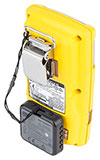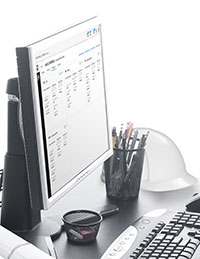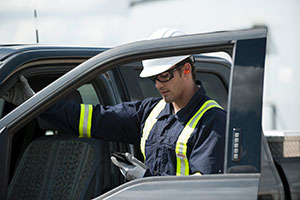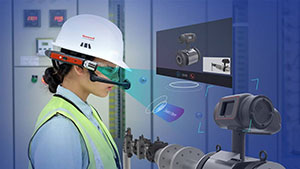Two forces are at work shaping the future of workplace safety: millennials and connectivity. This article looks at developments igniting this twin dynamic.
What’s Hot, What’s Now
Gaining practical advantages from connected devices at the intelligent edge is an increasingly powerful advantage for many companies. This week, Honeywell is rolling out three connected devices, with major benefits:
Automating safety processes:
SafetySuite Device Manager is a cloud-based software solution that enables companies to manage fleets of Honeywell BW Technologies and RAE Systems detectors across multiple sites. It automates the configuration, testing, firmware updates, scheduling reports on tests, safety events and incident investigations.
Adding connectivity to existing field devices:
BW Connect is a Bluetooth-enabled device that brings connectivity to Honeywell BW portable, multi-gas detectors so companies can remotely monitor their employees’ safety, respond to emergencies faster, and avoid costly downtime. The new device allows companies to add connectivity to hundreds of thousands of Honeywell gas detectors in service today.
Enhancing safety in confined spaces:
The new Honeywell BW™ Ultra a new connected portable gas detector designed to keep workers safe in dangerous confined spaces. It monitors up to five different gases simultaneously, including volatile organic compounds (VOCs), while leveraging Bluetooth connectivity to allow safety managers to collect and track valuable data. The new detector also features Honeywell TouchConnect™ technology, which makes configuration, calibration and bump testing fast and simple.
Learn more about Honeywell's Connected Worker Solutions
Baby boomers, those born after World War II and before 1960, are retiring at a rate of 10,000 people daily in the United States. In heavy or hazardous industries, the numbers are more staggering—for example, an estimated 25% of manufacturing experts are expected to retire within a few years. The average age of a skilled manufacturing worker is 56, according to an article in Bloomberg.
Coinciding with boomers who are exiting is an economy that’s booming. As many as 600 major semiskilled professions were expected to have realized a growth rate of 5% or more by the end of 2017.1 That’s a high demand for new workers — and for new worker training to ensure that all individuals entering the workforce will have the specific skills and education to perform the job at hand.
Millennials, who recently surpassed boomers as the largest population group, are poised to succeed in an industrial economy that’s growing and increasingly connected. Having grown up on smart phones, laptops, digital games and educational devices, Millennials find it second nature to be “connected” on the job as well. In this sense, “connected” means digital, online, mobile and engaged. These expectations are being met by some of the most recent advancements in Internet of Things (IoT)-enabled safety technology, smart wearables, Augmented/ virtual reality and wireless instrumentation. Honeywell is in the vanguard of today’s developments.
Here are a few trends defining the Connected Worker profile that Millennials are fitting into:
An appetite for apps
Millennial workers (like many of their older counterparts) may lack the patience to page through a paper manual. But smartphones or tablets hold their attention, and offer instant access and simple to use interfaces, resulting in what Honeywell terms an enhanced human user experience, or HUE, something the company designs into all its new connected products.
 So manufacturers increasingly offer smartphone apps to accompany leading safety equipment. For example, devices such as BW Ultra, BW Clip, MicroRAE, and Sensepoint gas detectors are documented in on-demand mobile training apps — with graphical simulations of their use and safety features. These can be downloaded and displayed on iOS or Android phones with a few swipes of the worker’s thumb.
So manufacturers increasingly offer smartphone apps to accompany leading safety equipment. For example, devices such as BW Ultra, BW Clip, MicroRAE, and Sensepoint gas detectors are documented in on-demand mobile training apps — with graphical simulations of their use and safety features. These can be downloaded and displayed on iOS or Android phones with a few swipes of the worker’s thumb.
 A tool such as the Honeywell Safety Communicator app provides even more directly protective benefits. Installed on a worker’s smartphone, it enables real-time communication between a remote monitoring system and devices such as the worker’s wearable gas detector. So should an emergency occur, a safety manager can be alerted by the monitor, react quickly, and provide any necessary assistance.
A tool such as the Honeywell Safety Communicator app provides even more directly protective benefits. Installed on a worker’s smartphone, it enables real-time communication between a remote monitoring system and devices such as the worker’s wearable gas detector. So should an emergency occur, a safety manager can be alerted by the monitor, react quickly, and provide any necessary assistance.
Get onto my Cloud - Securely
Cloud-based connectivity technology enhances the safety of the modern worker through its ability to transmit and receive information almost instantaneously, in real time. Keeping track of worker inventory, mobility on the job and safety status is being advanced through embedded scannable RFID chips, sensors and other connected elements into Honeywell safety harnesses, wearable gas detectors, gloves, and other personal protective equipment (PPE) to create smart PPE. Using secure cloud-based data transmission and storage, real-time information can be collected from an entire ecosystem of PPE and made available to stakeholders across the enterprise.
 At a minimum, a smartphone or tablet can be used to ascertain any given PPE item’s serial number. But many manufacturers today also make provision for a scan to reveal additional data. Thus software such as SafetySuite can help furnish the worker with on-demand assignment, training, and safety compliance information for that specific item, on the spot.
At a minimum, a smartphone or tablet can be used to ascertain any given PPE item’s serial number. But many manufacturers today also make provision for a scan to reveal additional data. Thus software such as SafetySuite can help furnish the worker with on-demand assignment, training, and safety compliance information for that specific item, on the spot.
Training where and when you need it
With more contract workers occupying jobs in hazardous industries, a great need has arisen for rapid, simplified, multimedia training made possible through connected devices, YouTube videos and live streaming media.
OSHA standards already include “explicit safety and health training requirements" and acknowledge that “training is an essential part of every employer’s safety and health program for protecting workers.” But with millennials filling new as well as existing positions, training methods and practices — to succeed — will need to evolve to “connect” with the new generation’s unique culture and expectations.
 And that is what’s happening now. To bridge the training gap, personal protective equipment (PPE), embedded with RFID and Bluetooth® wireless technology, enable workers to use their smartphones to transform PPE into an edge device that can collect and transmit data. For example, a worker, via connected PPE, will be able to access immediate, on-demand training on the use of that equipment, including tutorial videos, check-lists or instructions in an intuitive app environment.
And that is what’s happening now. To bridge the training gap, personal protective equipment (PPE), embedded with RFID and Bluetooth® wireless technology, enable workers to use their smartphones to transform PPE into an edge device that can collect and transmit data. For example, a worker, via connected PPE, will be able to access immediate, on-demand training on the use of that equipment, including tutorial videos, check-lists or instructions in an intuitive app environment.
Other workers may use a smartphone app to connect with a security gate enabled with RFID or Bluetooth identifiers and immediately access — on a check-list — whether they have appropriate training and are wearing the right PPE to access a hazardous area. Safety managers in remote locations can also automatically receive this data, on their smartphones via the cloud, to remain connected to monitor the individual safety of off-site or lone workers in high-risk jobs or working environments. In the future, on-demand training apps could even give workers the option to receive the e-training they need on the spot.
Intelligent head gear is here
Today’s hard hats are not your father’s generation’s hard hats. Millennials entering rugged, hazardous industries today increasingly are wearing protective head gear with telephonic, voice-activated technology and computer-mounted displays. These allow hands-free operation while providing a wealth of data to workers that allows them to more safely, reliably and efficiently accomplish their tasks. This new wearable technology enables communication bi-directionally, in other words, it connects field workers with remote experts in real time.
 One state-of-the-art example is Honeywell’s Skills Insight Intelligent Wearable, which features a head-mounted visual display that responds to voice and brings live data, documents, work procedures, as well as health and safety information into view. It is a 100 percent hands-free, rugged head-mounted computing platform. It also is acceptable for use in explosive areas (Zone 1, Class 1/Division 1) that require intrinsically safe certification.
One state-of-the-art example is Honeywell’s Skills Insight Intelligent Wearable, which features a head-mounted visual display that responds to voice and brings live data, documents, work procedures, as well as health and safety information into view. It is a 100 percent hands-free, rugged head-mounted computing platform. It also is acceptable for use in explosive areas (Zone 1, Class 1/Division 1) that require intrinsically safe certification.
Honeywell also offers wireless earmuffs that allow workers to stay connected while protecting hearing on noisy job sites. The earmuffs integrate Bluetooth wireless technology allowing workers to talk on the phone, connect with co-workers, get instructions and perform tasks without sacrificing hearing protection.
From Virtual to Actual: Safety Technologies in the Making
Another recent development in training technology is virtual reality (VR) education. It’s an experience that millennials especially seem to enjoy. Workers can now wear a VR helmet or goggles, and perhaps gloves, to practice safe working procedures in an immersive 3D space. This can strengthen the muscle memory of performing actions correctly, while the realism and emotional impact of an exciting VR experience helps fix the lesson in memory for the long term.
AR could be used to supplement or refresh previous safety training, enabling millennial workers to access the training information — perhaps even “live” on-site and in the moment — rather than relying on memory or printed manuals. More generally, apps and touchscreens should proliferate, making safety measures easier to access and execute for all workers. These technologies will connect to more — and even more innovative — implementations of smart PPE and connected safety software. The end game is to enable workers to more easily and quickly review or learn how to perform a given task, which could dramatically increase their safety.
In the not so far-off future, wireless near field communication (NFC) capabilities — which allow a card or smartphone to establish ID when waved within 4 cm of a terminal — could be added to eyewear, fall protection gear, hardhats, etc. So workers could access each item’s maintenance/replacement dates, or where it can/should be worn in the plant. Another advance: wearable micro-sensors could let managers continually monitor every worker’s health and safety variables. These might include noise levels, radiation exposures, and perhaps even posture or acceleration impacts.
Look for voice recognition, artificial intelligence and continuing advancements in connected wearables to further transform the safety space. In the coming years, all these technologies should help guide today’s millennials into a working world that’s safer and more productive.